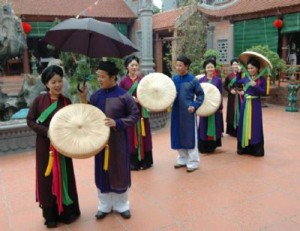Quan ho Bac Ninh is folk songs of the Red River Delta, concentrates mainly in Kinh Bac region (provinces of Bac Ninh and Bac Giang). This is a kind of art composed by the elements of music, lyric, costume, festival… Quan ho Bac Ninh folk songs show close-knit relation between male singers (lien anh) and female singers (lien chi) and are typical culture of Kinh Bac region’s people. Quan ho folk songs always use in The Lim Festival in Bac Ninh province.
Quan ho folk songs passed from generation to generation through oral have the most melodies in Viet Nam’s folk-song genres. Quan ho folk songs are always performed voluntarily in groups of male (bon nam) or female (bon nu). Each group usually has four to six people who are named by order such as “Second Sister”, “Third Sister”, “Fourth Sister”, or “Second Brother”, “Third Brother”, “Fourth Brother” and so on. If the size of a group reaches seven or eight people, then they are divided into “older siblings” and “younger siblings” named as the “Third Older Sister”, “Third Younger Sister” or “Third Older Brother”, “Third Younger Brother”…
 Quan ho folk songs are alternating response songs between the groups of male and female. A group of female from one village sings with a group of male from another village with similar melodies, but different lyrics, and always with alternating tunes. In each group, one person sings the leading tune and another sings a secondary part, but the two should be in perfect harmony at the same timbre. Quan ho folk songs have 213 different melody variations and more than 400 song lyrics. A song lyric includes two parts: the principal text is the core of the song, containing its base lyrics. The lyrics of Quan ho folk songs derived from poems and folk verses of the Viet Nam, mostly 6 syllable and 8 syllable verses, modified 6 syllable and 8 syllable verses, 4 syllable or mixed 4 syllable verses express people’s emotional states in metaphorical language. The secondary text includes words that are added to the melodies, such as i hi, u hu, a ha…
Quan ho folk songs are alternating response songs between the groups of male and female. A group of female from one village sings with a group of male from another village with similar melodies, but different lyrics, and always with alternating tunes. In each group, one person sings the leading tune and another sings a secondary part, but the two should be in perfect harmony at the same timbre. Quan ho folk songs have 213 different melody variations and more than 400 song lyrics. A song lyric includes two parts: the principal text is the core of the song, containing its base lyrics. The lyrics of Quan ho folk songs derived from poems and folk verses of the Viet Nam, mostly 6 syllable and 8 syllable verses, modified 6 syllable and 8 syllable verses, 4 syllable or mixed 4 syllable verses express people’s emotional states in metaphorical language. The secondary text includes words that are added to the melodies, such as i hi, u hu, a ha…
Quan ho folk songs exist in a cultural environment with their own social customs. The first is friendship custom among Quan ho villages. From the friendship custom, a special social custom appears among Quan ho groups. It’s friend-making custom. Each Quan ho group from one village makes friends with another group from another village following the principle that male groups make friends with female groups and vice versa. With the friendship-partner villages, men and women in Quan ho groups from these villages are not allowed to marry each other.

One particular characteristic of Quan ho singing is the teaching and dissemination through “sleepover” custom. Boys and girls from 9 to 16 or 17 years old, invite each other to sleep over in their host’s house to learn Quan ho singing techniques. Male and female singers combine and practice their voices in pairs in order to have a unified timbre for performance.
Quan ho gastronomy uses phoenix wing-shaped quid of betel and areca, Thai Nguyen tea. In meal, it must use red tray (mam son) which is made of timber and painted red to express host’s emotion to visitors. Dishes in the meal depend on each village’s custom but must include a plate of chicken, two plates of lean pork paste, lean pork; especially no fat dishes to avoid damaging voice.
In performance, the outfits of Quan ho are distinctive. The female costume includes non thung quai thao (the large round Quan ho hat) and scarf for wrapping the hair, camisole, tunic, skirt, scarves tied about the waist and slippers. The male costume includes turban, umbrella, shirt or robe including undershirts and long tunics with five pieces, trousers and slippers.
At 16h55 on September 30, 2009 in Abu Dhabi Capital of United Arab Emirates, UNESCO recognized Quan ho Bac Ninh folk songs as intangible cultural heritage of humanity for its cultural value, social custom preservation, performing arts, style of contact, lyric and costume. The recognized region includes 49 traditional Quan ho villages. 44 of these villages now lie in Bac Ninh Province: Bai Uyen, Due Dong, Ha Giang, Hoai Thi, Hoai Trung, Lung Giang, Lung Son, Ngang Noi, Van Kham, Tam Son, Tieu, Dong Mai, Dong Yen, Bo Son, Cham Khe, Co Me, Duong O, Dau Han, Dieu Thon, Dong Xa, Do Xa, Hoa Dinh, Huu Chap, Kha Le, Khuc Toai, Nem Doai, Nem Son, Nem Tien, Niem Xa, Phuc Son, Thanh Son, Thi Chung, Thi Cau, Tho Ninh, Thuong Dong, Tra Xuyen, Ve An, Viem Xa, Xuan Ai, Xuan Dong, Xuân O, Xuan Vien, Y Na, Yen Man. The remaining 5 traditional villages are located in Bac Giang Province: Gia Son, Huu Nghi, Noi Ninh, Mai Vu, and Sen Ho.
The Royal Refined Music (Nha Nhac) of Hue is also a Masterpiece of the Oral and Intangible Heritage of Humanity!
[Source]
